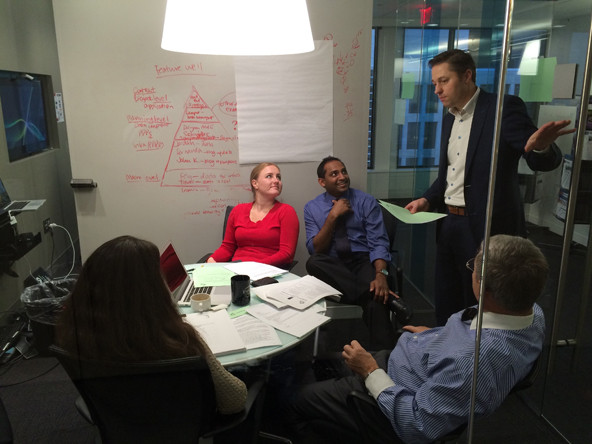 The Private Infrastructure Advisory Facility team playing a PPP game at the World Bank in Washington, DC. (Photo by Douwe vanAkkerveeken)
The Private Infrastructure Advisory Facility team playing a PPP game at the World Bank in Washington, DC. (Photo by Douwe vanAkkerveeken)
In the past year, massive sinkholes opened up in suburban Atlanta, suburban Detroit, New York City, San Antonio, and San Francisco, partially as a result of decaying water, drain, and sewer pipes. These events caused massive amounts of damage. In a Detroit suburb, a sinkhole the size of a football field swallowed parts of three homes, forced the closure of a major road, and led to the evacuations of more than 20 families. These are just a few of the indicators showing us that the United States needs to invest in infrastructure. Now.
Infrastructure, after all, is the backbone of the economy. George Washington recognized this when, in 1784, he personally surveyed part of what eventually became the United States’ first National Road. We need our ports, highways, bridges, trains, water, waste treatment, electric, telecommunications, and Internet infrastructure to be in good condition. Where infrastructure falls apart or simply does not exist, we lose our quality of life, our incomes, and our competitiveness.
Yet the American Society of Civil Engineers (ASCE) estimates that the United States needs $4.56 trillion to keep its deteriorating infrastructure current but only has funding to cover less than half of necessary infrastructure spending—leaving the at least country $2.0 trillion short through the next decade. Globally, the picture is bleak as well: World Economic Forum estimates that the infrastructure gap is $1 trillion each year.
What can be done? Some argue that public-private partnerships (PPPs or P3s) are the answer. We agree that they can play an important role—if done well. In a PPP, a private party provides a public asset or service for a government entity, bears significant risk, and is paid on performance. The upside for governments and their citizens is that the private sector can be incentivized to deliver projects on time, within budget, and with reduced construction risk. The private sector can benefit by earning a steady stream of income from a long-term investment from a secure client. From the Grand Parkway Project in Texas to the Queen Alia International Airport in Jordan, PPPs have succeeded domestically and internationally.
Are you enjoying this article? Read more like this, plus SSIR's full archive of content, when you subscribe.
The problem is that PPPs can be very hard to design and implement. And since they can involve commitments of millions or even billions of dollars, a PPP failure can be awful. For example, the Berlin Airport is a PPP that is six years behind schedule, and its costs overruns total roughly $3.8 billion to date.
In our experience, it can be useful for would-be partners to practice engaging in a PPP before they dive into a live project. At our organization, Tetra Tech’s Institute for Public-Private Partnerships, for example, we use an online and multiplayer game—the P3 Game—to help make PPPs work.
The game is played with 12 to 16 people who are divided into two teams: a Consortium and a Contracting Authority. In each of four rounds, players mimic the activities they would engage in during the course of a real PPP, and as in real life, they are confronted with unexpected events: The Consortium fails to comply with a routine road inspection, how should the Contracting Authority team respond? The cost of materials skyrockets, how should the Consortium team manage when it has a fixed price contract?
Players from government ministries, legislatures, construction companies, financial institutions, and other entities get to swap roles and experience a PPP from different vantage points. They think through challenges and solve problems together—practicing, failing, learning, and growing—within the confines of the game and with no real-world cost.
More than 1,000 people have participated to date, including representatives of the US Army Corps of Engineers, the World Bank, and Johns Hopkins University, using a variety of scenarios. PPP team members who work on part of the Schiphol-Amsterdam-Almere Project, a $5.6-billion road project in the Netherlands, played the game using their actual contract document.
In the defense sector, where real-world failures can cost millions of lives and billions of dollars, people use games to test assumptions, and expose policy and capability gaps. For example, the Center for New American Security recently ran an intense two-day exercise for 70 people from Europe and the United States. They were divided into six teams representing France, NATO, Norway, Russia, the United Kingdom, and the United States; each had to respond to increasingly escalatory actions in the North Atlantic passage between Greenland and Iceland.
To help address public health crises and better manage health systems, the Centers for Disease Control, Columbia University, the University of Minnesota, and many others have been developing games. Whether the games involve playing out responses to a natural disaster, water-borne illness, or infectious disease, they allow people to practice different types of responses and see if they result in different outcomes.
As we strive to find solutions to issues ranging from the global infrastructure gap to global health pandemics, we need to recognize that the answers are out there. Figuring out those answers may be hard, but the process can also be enjoyable. We believe that games hold enormous possibility for gaining insight into the biggest challenges. In that spirit, we encourage all those working on social issues to find or create games to help them. And keep playing until you win.
Support SSIR’s coverage of cross-sector solutions to global challenges.
Help us further the reach of innovative ideas. Donate today.
Read more stories by Nilmini Rubin & Jennifer Hara.

